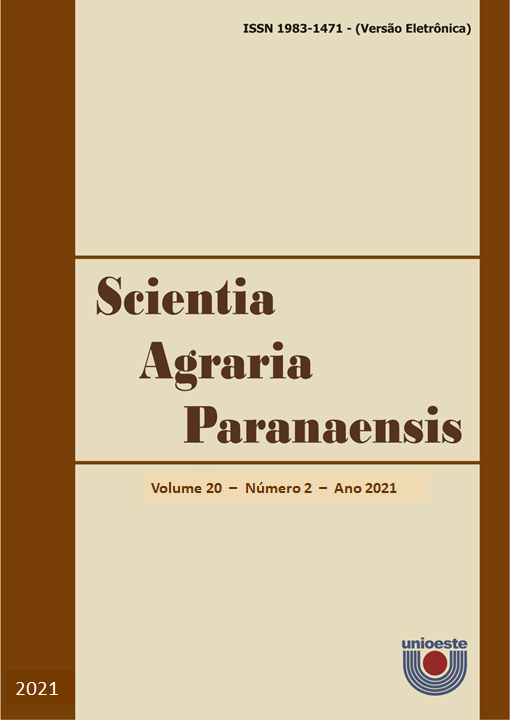Substrate and indolebutyric acid in the rooting of pomegranate cuttings collected in two seasons
DOI:
https://doi.org/10.18188/sap.v20i2.25322Resumo
The pomegranate (Punica granatum L.) presents potential for commercial exploitation as a fruit, ornamental or medicinal plant. However, for its usage in orchards, it is ideal that the seedlings come from vegetative propagation techniques. The aim of this work was to test the usage of indolebutyric acid (IBA) and substrates, at two harvesting times (before and after fruiting) in the cutting propagation of pomegranate. The work was carried out at UTFPR, Campus Dois Vizinhos. The experiments were installed in a randomized block design, in a 4 x 4 factorial scheme (IBA concentration x substrate), with four replications and ten cuttings per experimental unit. IAB was tested at concentrations 0; 1000; 2000 and 3000 mg L-1. The used substrates were Red Latosol, medium textured sand, commercial substrate MecPlant® and a mixture of Red Latosol + sand + commercial (1:1:1, v/v). The cuttings were placed in beds in a screened protected environment, with 50% shading. Irrigation was performed three times a day for 30 min., by a micro sprinkler. After 60 days, rooting (%), cuttings with callus (%), number of primary leaf and root shoots, length of the three largest roots and percentage of dead cuttings were evaluated. Cutting presented itself as a potential technique to be adopted for pomegranate, using sand, with the use of IBA at concentrations between 1600 and 1750 mg L-1. Cuttings must be collected before fruiting. However, rhizogenesis close to 50% was achieved at the time after such phenological stage.
Downloads
Publicado
Como Citar
Edição
Seção
Licença
Aviso de Direito Autoral Creative Commons
Política para Periódicos de Acesso Livre
Autores que publicam nesta revista concordam com os seguintes termos:
1. Autores mantém os direitos autorais e concedem à revista o direito de primeira publicação, com o trabalho simultaneamente licenciado sob a Licença Creative Commons Attribution que permite o compartilhamento do trabalho com reconhecimento da autoria e publicação inicial nesta revista.2. Autores têm autorização para assumir contratos adicionais separadamente, para distribuição não-exclusiva da versão do trabalho publicada nesta revista (ex.: publicar em repositório institucional ou como capítulo de livro), com reconhecimento de autoria e publicação inicial nesta revista.
3. Autores têm permissão e são estimulados a publicar e distribuir seu trabalho online (ex.: em repositórios institucionais ou na sua página pessoal) a qualquer ponto antes ou durante o processo editorial, já que isso pode gerar alterações produtivas, bem como aumentar o impacto e a citação do trabalho publicado (Veja O Efeito do Acesso Livre).
Licença Creative Commons
Esta obra está licenciada com uma Licença Creative Commons Atribuição-NãoComercial-CompartilhaIgual 4.0 Internacional, o que permite compartilhar, copiar, distribuir, exibir, reproduzir, a totalidade ou partes desde que não tenha objetivo comercial e sejam citados os autores e a fonte.


